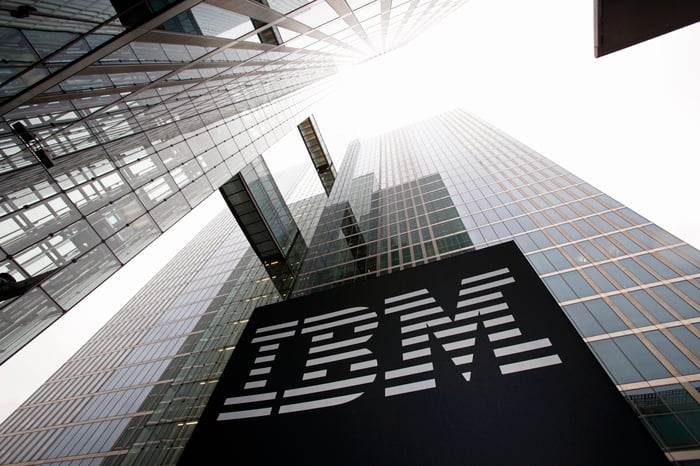
This businessman is not thinking outside the box -- yet. Image source: Getty Images.
All work and no play makes Jack a dull boy. The same goes for large businesses -- putting all of your company's effort into a single product can lead to stagnation and stale ideas. Exploring new ideas is one way to keep your company relevant for the long haul, even if the side business doesn't have much to do with your main operations.
You're about to see some examples of this from large household names in the American business world. We will explore some interesting side projects from Tesla (TSLA -3.55%), Walt Disney (DIS -0.45%), Alphabet (GOOG 0.37%) (GOOGL 0.35%), IBM (IBM -0.89%), and Amazon.com (AMZN -1.14%). These ideas may grow into their breeches over time, but they look kind of crazy right now.
Pixelbots swarming to show a rainbow dinosaur. Image source: Walt Disney.
Disney tackles robotics
You've seen Disney robots at their theme parks -- animatronics have been a vital part of the Disneyland and Disney World experience for decades. But the House of Mouse didn't stop there.
The company is not only advancing the state of the art in basic robotics, but also working out better ways to interact with computers and machines. Disney is building two-legged robots with the ability to walk on top of a ball, a swarm of robots with colored lights acting as pixels in a larger image, and human-like machines that could play catch with actual humans.
Some of these technologies will surely be used in future theme park attractions or in the movie studio, but that's not all. Look back at the ambitious Experimental Prototype Community of Tomorrow park, better known as EPCOT, for examples of Disney thinking far outside the theme park box, followed by the experimental community of Celebration, Florida. Those robots might find their way on regular city streets in the end.

Alphabet -- yes, Google's parent company -- wants to cure death. Image source: Getty Images.
Alphabet wants to crack human aging
The company formerly known as Google still collects more than 99% of its quarterly revenue from that division's online search and advertising operations. That hasn't stopped Alphabet from pursuing a number of interesting side businesses, many of which hold serious promise in the far future.
Among Alphabet's many side bets, the most interesting one is the medical research lab known as Calico.
Created as a division of Google, and later of Alphabet, Calico wants to stop or slow human aging. This is done by a combination of traditional medical research and advanced data analysis. Calico is led by a crack team of medical scientists, and is quick to collaborate with other medical experts and research universities along the way. Futurist Ray Kurzweil, who hopes to achieve immortality for himself and others, is an advisor to Calico.
Stop aging, heal any ailment, live forever. That's probably the most ambitious business idea I've ever seen.

This traditional-looking clay tile roof is actually Tesla's solar power roofing. Image source: Tesla.
Tesla's energy hobby, soon to be the main business
We know Tesla as a maker of fast, upscale electric cars. That's what pays the bills today and how the company got to where it is.
But the company's ultimate plan is to become an energy company, and those electric cars are only a small piece of that long-term strategy. The Gigafactory is building batteries on a game-changing scale, and the SolarCity buyout added solar panel installations and Powerwall battery packs to Tesla's business operations.
Energy products accounted for just 12.5% of Tesla's total sales in the second quarter of 2017 and the growth rate is slowing down while Tesla shifts its focus from sales volume to profitability. That crazy side business is growing up in a hurry, and you won't think of Tesla as a pure car maker for much longer.

This is now an Amazon store. Image source: Whole Foods Market, an Amazon subsidiary.
Amazon, the traditional retailer
The e-commerce giant may have destroyed many old-school brick-and-mortar retailers over the years, but Amazon has also started to become one of those traditional ones recently.
The biggest splash so far came with Amazon's buyout of Whole Foods Market, a nationwide chain of supermarkets with a focus on organic products. So Amazon is selling groceries in your neighborhood now, and will also use the store network to smooth out its deliveries and returns of other products. Whole Foods is a small cog in Amazon's much larger business machine, expected to generate roughly 9% of the combined company's total sales.

IBM's Watson research center in Munich, Germany. Image source: IBM.
IBM: The ultimate research lab
Big Blue is the undisputed king of innovation. In each of the last 24 years, IBM has been granted more U.S. patents than any other company. Most of these innovations are related to IBM's core operations, such as artificial intelligence and cloud computing. But it's almost impossible to produce 8,000 patents a year without touching some unusual ideas along the way.
You'll find a few off-the-wall gems among IBM's recently granted patents:
- Patent No. US20170174343: Drone delivery of coffee based on a cognitive state of an individual
- Patent No. US9538335: Inferring device theft based on historical location data
- Patent No. US20150002312: Method to mitigate honking of vehicles
Some of these interesting patents may eventually make their way into real business products and services while others become stepping stones toward learning larger lessons. Zoom out and you'll notice a data analysis link between the three examples above. Either way, this isn't exactly the enterprise computing stuff you thought IBM was made of.





